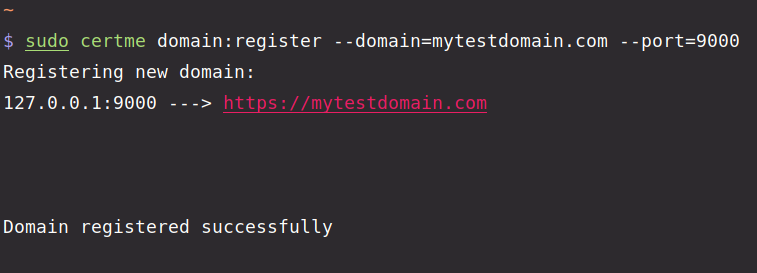certme v2.0.0
certme
A CLI used to create a local https dev environment with the green lock. Setup takes less than 5 minutes and all of your projects will be running locally over HTTPS with custom domain names in no time!
Introduction
So you have a lot of projects running locally. To get to them, you visit http://localhost:8080. If you want HTTPS, you always get that "warning" window from your browser saying it's not safe. What's worse is that each system has different seeded users, now you need to remember the username and passwords for each one because your browser can't tell the difference between http://localhost:3000 and http://localhost:9000.
This CLI is the answer to all of your problems. It allows you to set up custom development domains and routes them to the correct port on your local machine. You can set https://mydev.local to point to http://localhost:8080 and your browser will trust the certificate!
Dependencies
I've decided that I don't really want to do all of the work, no need to reinvent the wheel. So there are a few things you need installed on your PC before starting here:
These two tools are used to generate the cert, use the cert and route traffic to the correct port.
I suggest you ensure that nginx is always running on system startup after you install it by using the following command:
sudo systemctl enable nginxGetting Started
Getting started is pretty easy! If you have nginx and mkcert installed, then you just need to install the CLI. You can pull the .deb file from the latest releases and then install it using gdebi or dpkg:
sudo gdebi -i certme.deb
# OR
sudo dpkg -i certme.debOnce the CLI is installed, you need to register your system username (the certificates are generated locally) and then start adding your domains.
And example of the commands would be as follows, you'll notice that it must be run as sudo since it edits the /etc/hosts file and creates an nginx config file.
sudo certme user:register $(whoami)
sudo certme domain:register --domain=mytestdomain.com --port=9000The user is the name of the account that you're logged into because we need to register the certificate authority and trust it under your account. This will then ensure that your browser picks it up!
And that should be it! Visit https://mytestdomain.com and you should see the green lock!

Now if you visit the domain:

Extra Functionality
There are a few extra features I've added to the project to improve the UX.
Autocompletion
You can add the autocompletion to one of your favourite shells. Just run,
certme autocompleteAnd follow the instructions to add it to your shell.
Route Check
If you want to see which port the custom domain you created is going to, you can use the endpoint: __local_https_route. For instance, if I've registered https://mytestdomain.com to point to port 9000, I can visit https://mytestdomain.com/__local_https_route and this is what I'd see:

Roadmap
This was my "POC" to ensure that I wasn't crazy and that it was possible to get this to work, there are a couple of features that I'd like to implement from this point:
- Create an
initcommand that installs everything for you and prompts you for the info needed for a better UX. - Use
dnsmasqinstead of editing thehostsfile so that I have wildcards... and I don't edit thehostsfile. - Create a frontend dashboard to show you what has been registered and allow you to make edits
- Create builds for all the different platforms:
deb,snap,AppImage, etc.
Usage
$ npm install -g certme
$ certme COMMAND
running command...
$ certme (--version)
certme/2.0.0 linux-x64 node-v14.17.3
$ certme --help [COMMAND]
USAGE
$ certme COMMAND
...Commands
certme autocomplete [SHELL]certme domain clear-allcertme domain listcertme domain registercertme domain removecertme help [COMMAND]certme user register USER
certme autocomplete [SHELL]
display autocomplete installation instructions
USAGE
$ certme autocomplete [SHELL] [-r]
ARGUMENTS
SHELL shell type
FLAGS
-r, --refresh-cache Refresh cache (ignores displaying instructions)
DESCRIPTION
display autocomplete installation instructions
EXAMPLES
$ certme autocomplete
$ certme autocomplete bash
$ certme autocomplete zsh
$ certme autocomplete --refresh-cacheSee code: @oclif/plugin-autocomplete
certme domain clear-all
Removes all of the registered domains
USAGE
$ certme domain clear-all
DESCRIPTION
Removes all of the registered domains
EXAMPLES
$ certme domain clear-allcertme domain list
Lists the existing domains that have been registered
USAGE
$ certme domain list
DESCRIPTION
Lists the existing domains that have been registered
EXAMPLES
$ certme domain listcertme domain register
Registers a new domain, creates the certificate, nginx config update and a change in the hosts file.
USAGE
$ certme domain register -d <value> [-p <value>]
FLAGS
-d, --domain=<value> (required) The domain that you would like to add to the system
-p, --port=<value> [default: 80] The port that this will be running on on your local machine
DESCRIPTION
Registers a new domain, creates the certificate, nginx config update and a change in the hosts file.
EXAMPLES
$ certme domain registercertme domain remove
Remove a domain from the registered domains
USAGE
$ certme domain remove -d <value>
FLAGS
-d, --domain=<value> (required) The domain that you would like to remove from the system
DESCRIPTION
Remove a domain from the registered domains
EXAMPLES
$ certme domain removecertme help [COMMAND]
Display help for certme.
USAGE
$ certme help [COMMAND] [-n]
ARGUMENTS
COMMAND Command to show help for.
FLAGS
-n, --nested-commands Include all nested commands in the output.
DESCRIPTION
Display help for certme.See code: @oclif/plugin-help
certme user register USER
Register a user that is on the system so that we can edit the trust servers for their account
USAGE
$ certme user register [USER]
ARGUMENTS
USER The username for the account using the browser (eg. run "whoami")
DESCRIPTION
Register a user that is on the system so that we can edit the trust servers for their account
EXAMPLES
$ certme user register


